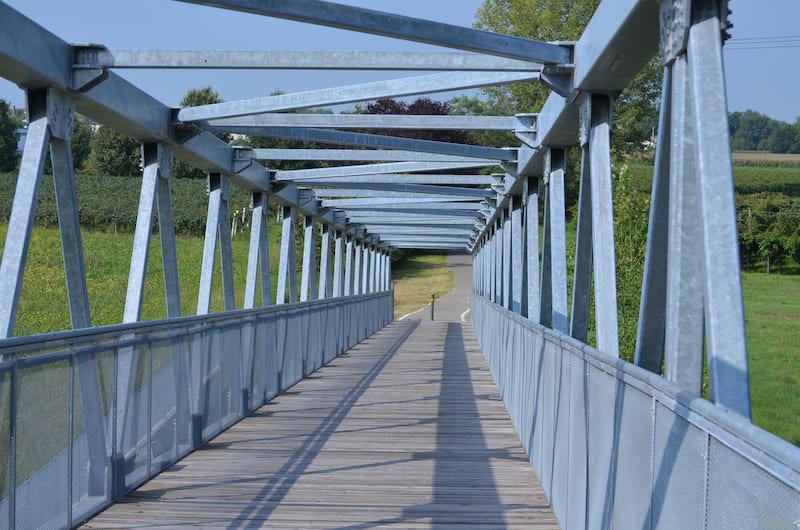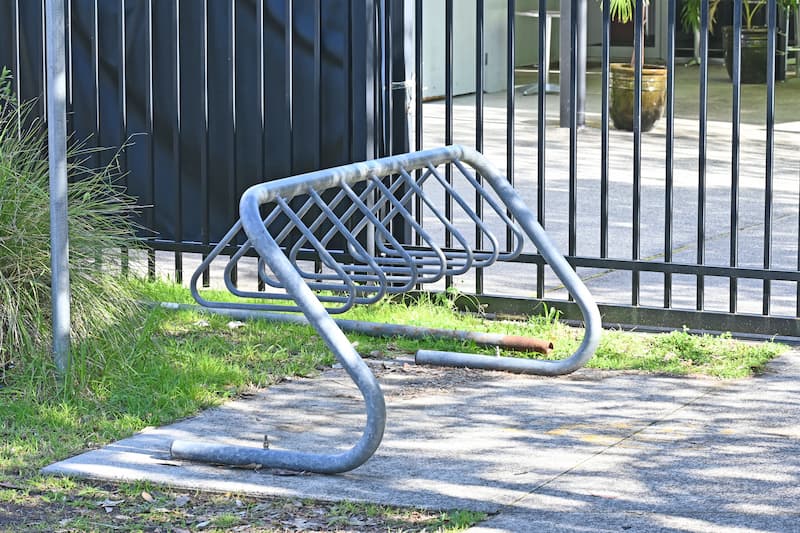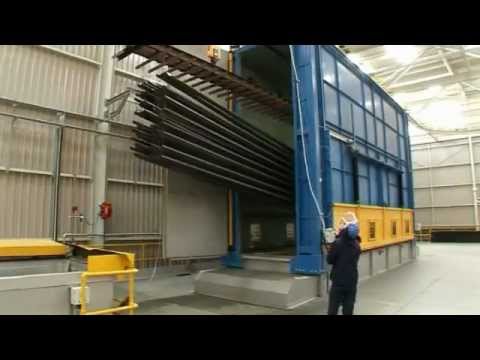Galvanisation involves coating iron and steel with a layer of zinc for superior corrosion protection. This plating method has been a cornerstone in industrial applications due to its cost-effectiveness and the long-lasting nature of the coating. Offering decades of durability, galvanised steel stands out against other anti-corrosive techniques, balancing cost-efficiency with environmental considerations.
In this article, we will explore this surface finishing technique and its ability to enhance a range of beneficial properties in steel.
What Is Galvanising?
Galvanisation or galvanising, as it is most commonly called, is a metal plating process in which an iron or steel component is coated with a thin layer of zinc. The zinc acts as a protective layer that shields the underlying surface from corrosion and extends its lifespan. The process may sometimes be driven by electricity until a sufficient thickness of the zinc layer is developed. This layer is not discrete, i.e. the zinc merges into the steel at the surface and forms a strong metallurgical bond.
Galvanising is commonly used in places where the metal needs to endure harsh environments or in structural applications where the metal needs to maintain its strength over many decades. The protective coating ensures that the base metal withstands challenging conditions without compromising its critical properties, such as tensile strength, elasticity and durability. The extensive utilisation of galvanised steel can be observed in the construction of bridges, guardrails and steel equipment in chemical plants.
Why Galvanise Steel?

The primary reason for galvanising steel is to increase its lifespan. Regular steel components, if not galvanised, can succumb to corrosion attacks and deteriorate quickly.
Even when embedded in concrete, steel products can corrode due to carbonation (exposure to carbon dioxide), moisture and high chloride levels. Applying a zinc coating improves the corrosion protection of the base metal and thereby enhances its durability.
Galvanising processes also provide the toughest coatings that can resist mechanical damage during transportation, storage and installation. The cost of installation is also low because galvanised components are ready to use upon arrival. Galvanised steel does not require any surface preparation, painting or inspection prior to installation.
Once installed, it provides a lifespan of over 50 years in rural areas and a minimum of 20 to 25 years in urban and coastal areas. The protective coating offers unparalleled protection by also covering sharp corners, recesses and other inaccessible areas. This feature is hard to find in some other coating processes.
Even when the coating is lost at a certain area, it still does not lead to corrosion because zinc has a higher negative reduction potential. This causes the zinc to oxidise instead of the iron, ensuring the safety of the application. To inspect the coating, only the physical condition of the layer is assessed. A close visual inspection is sufficient. If the coating appears intact, we can be confident that no damage has occurred to the steel underneath.
Galvanised steel is generally a cost-effective alternative compared to other methods, except for some large-scale applications. In the construction sector, galvanised steel may become so expensive that builders may abandon the idea of using it altogether when the budget is restrictive. A second disadvantage is that, although the zinc layer is resistant to red rust, it can still develop white rust when continuously exposed to moisture.
Galvanising Methods

There are several galvanising processes available, each with its own advantages and limitations. Let’s take a look at some of the most common galvanisation methods in use today.
Hot-dip galvanising
Hot-dip galvanising is one of the most straightforward and economical galvanising methods. It is capable of coating a variety of complex shapes with relative ease. The surface of the material is cleaned of contaminants and any oxides before being dipped in a molten zinc bath. The bath of molten zinc applies a layer of zinc coating onto the steel component. The quality of the metallurgical bond is determined by how efficiently the surfaces were cleaned beforehand.
Electrolytic galvanising
Electrolytic galvanising, also known as electrogalvanising, is the second most widespread galvanising method. It uses electrolysis to apply a layer of zinc onto a base metal, making it a form of electroplating. In this process, the steel workpiece is placed in a zinc solution with a second electrode and then direct current is passed through it. The current ionises the zinc solution, depositing a pure zinc coating on the base metal. This process provides greater control over the rate of deposition and the layer thickness.
Sherardising
Sherardising is a type of galvanising process named after its inventor, Sherard Osborn Cowper-Coles. It uses thermal diffusion to create a zinc coating on ferrous metals. In this process, the metal to be coated is placed in a container with zinc metal dust. The temperature of the workpiece is increased to 400-450 °C in the presence of this dust. The high temperature causes the dust to diffuse into the metal, forming a zinc-iron alloy.
Pre-galvanising
Pre-galvanising can be understood as a type of hot-dip process adapted specifically for long steel sheets. In this process, the sheet is passed through a cleaning agent that prepares the material for galvanising. Once the metal sheet has been cleaned, it is quickly passed through a molten zinc bath. The rapid movement enables the formation of a thin protective zinc coating that is more uniform than the one achieved in the conventional hot-dip galvanising method. This method provides the fastest turnaround times for sheet metal.
Hot-Dip Galvanising Process
As mentioned previously, the hot-dip process is the most widely used method for galvanising steel components. It provides a reliable method for coating various shapes and sizes, ranging from nuts and bolts to large structural beams. The complexities can range from simple steel rods to artistic pieces with intricate shapes.
In this section, we’ll explain the general hot-dip galvanising process to understand its stages and their purpose. The process can be divided into four major stages:
- Removal of hard contaminants
- Chemical cleaning
- Flux application
- Immersion in a zinc bath
Removal of Hard Contaminants
When the surface of a workpiece contains hard contaminants, such as welding slag, heavy grease and paint, chemical cleaning is not going to cut it. These impurities must be removed beforehand by using a paint stripper or by mechanical means such as blasting, grinding, etc, as they’ll affect the final quality of the galvanised products. Once the surface is free of any hard contaminants, chemical cleaning will be sufficient to further prepare the part for immersion in a zinc bath.
Chemical Cleaning
In the chemical cleaning stage, all contaminants, such as dirt, grease, scales and oxides, will be removed from the surface of the steel.
To achieve this, several operations take place in sequence. The first step is degreasing, where the component is dipped into a caustic solution, held for a predetermined amount of time, and then rinsed.
After removing the surface grease, the part is immersed in a hydrochloric acid solution to eliminate mill scale and oxides. It is then rinsed once more. This step is also known as the acid pickling process.
Flux Application
Once out of pickling, the part’s exposure to air can lead to the formation of a very thin oxide layer on its surface. This layer can interfere with the adhesion of the zinc coating to the steel component and, therefore, needs to be removed.
To accomplish this, the component is exposed to a chemical flux (typically zinc ammonium chloride) that facilitates the dissolution of the surface oxide into it. The concentration varies from case to case. The flux usually also contains wetting agents, anti-foaming agents and viscosity adjusters. The flux is allowed to dry before being dipped into liquid zinc.
Immersion in Zinc Bath
Immersing steel parts in a tank of molten zinc
After applying flux, the openings for venting and draining on the component are checked before the actual dipping process. The air will exit through the vent opening, while the molten zinc will enter through the drain opening.
Once they are found to be satisfactory, the part is cleared to go through the hot-dip galvanising process. The component is immersed in a bath of molten zinc at 450°C. The bath cannot be heated too much, as excessive temperature can cause the chemical flux on the component to burn away. The component is held in place until its temperature becomes equal to that of the bath.
The immersion creates layers of zinc-iron alloys with different compositions. There is no clear demarcation between the layers, and the steel component gradually transitions into a pure zinc coating on the surface.
Upon successful coating, the component is cooled down in a quench tank to prevent exposure to air.
Wrapping It Up
Galvanisation is an excellent method for providing low-cost and effective protection to steel and other ferrous metals. The formed coating is strong, corrosion-resistant and durable. As a result, the process has found widespread usage across various industries, ranging from the production of fasteners to the construction of entire stadiums. Thus it is important to ensure that all the necessary steps of galvanisation are carried out properly to achieve a reliable finish and desired performance.


